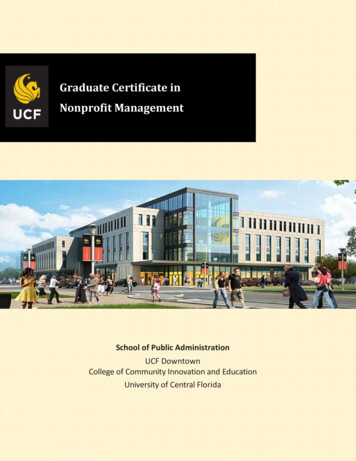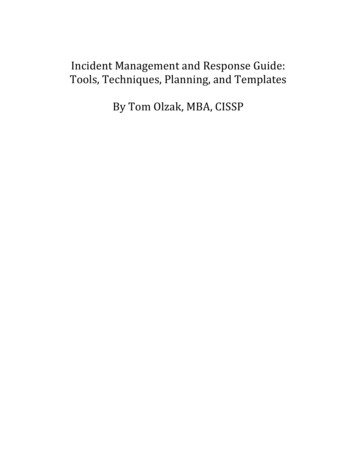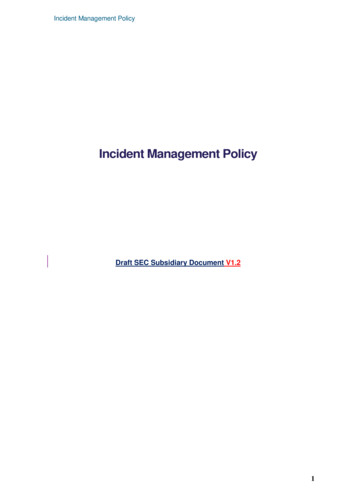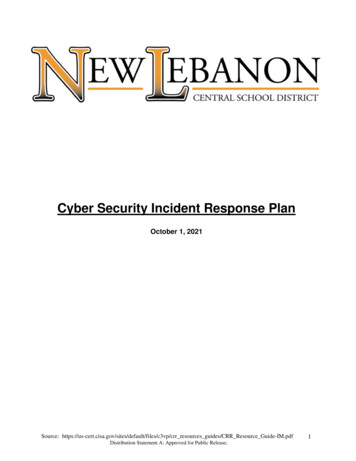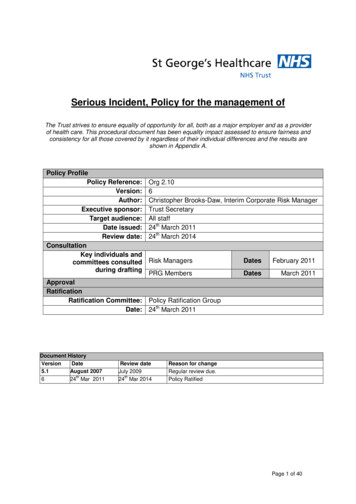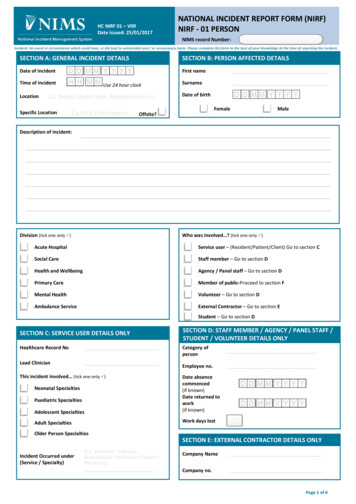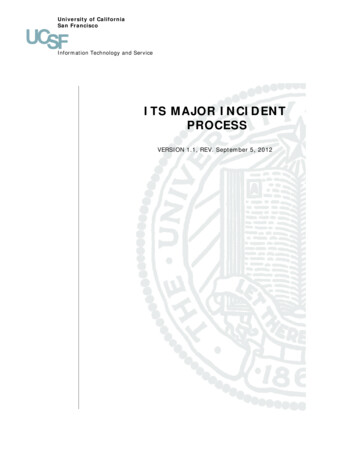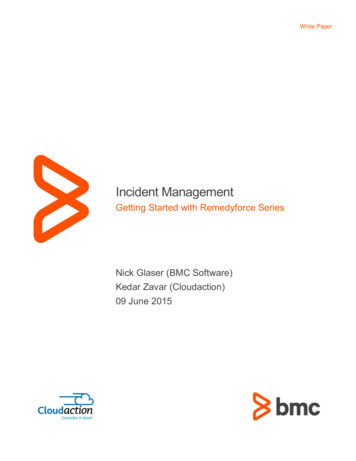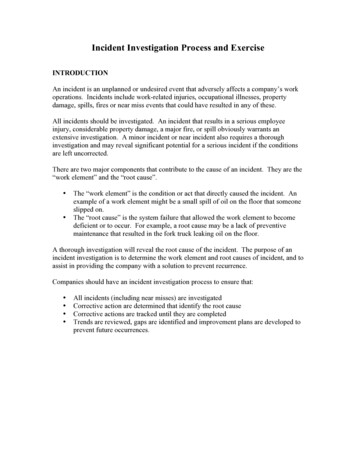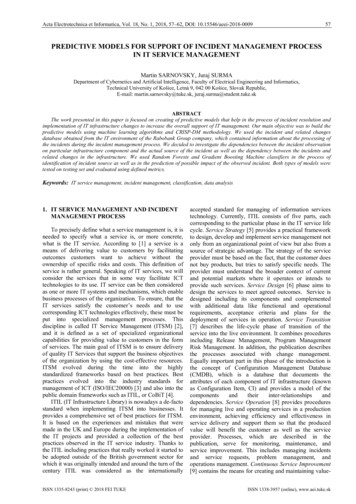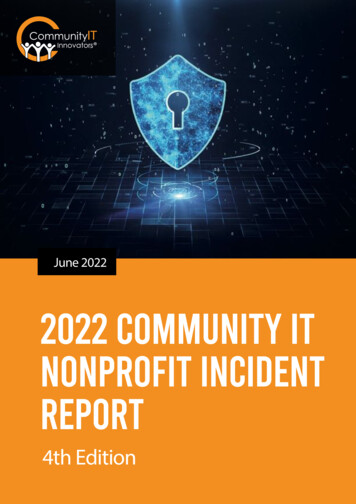
Transcription
June 20222022 COMMUNITY ITNONPROFIT INCIDENTREPORT4th Edition
Table of ContentsIntroduction2Executive Summary3Cybersecurity Landscape5Definitions8Incident Categories9Analysis13Incident Trends15Insights17Three Next Steps to Protect Your Nonprofit Organization18Cybersecurity Basics for Nonprofits19Matt Eshleman211
Introduction!"# %& '() #** &&, - .(//0 ,12 3!4& 51" # 0#6 7( 8)(',1 3 *,9 1 : 8()1; 31 1#% & # 6(1 (' ''()1 1( 801 1",& 1(- 1" ) 01 ,1 "#& # )2 " 68'06 ) &(0)* '() 0& #& ? 1#% # &1 8 #*% 1( ) , ? # 9 # #62@ 1" & *0),12 , *,9 1& 1"#1 (0) *6, 1& A8 ), * 9 # 9 1"#1 (0)& ) ,* 9 &% ?#& ) &8( &, 6 '() #99) &&, -;!"# %&'( )&* & ','#- .'/&,0(#1&2 '33 04 /"& &.5(#/% 2'/' /"'/ 05( /&'6 "' (& 70-2&2 /089- (& 70- & /0 06& '22#/#0-'3 /"(&'/ : )&* & '22&2 ' 4&) #-.#2&-/ .3' #4#.'/#0- /0 05((&70(/#-, '-2 '22&2 #- 2'/' 4(06 ' 7(& #05 %&'( /0 7(0 #2& 06& '22#/#0-'3 .0-/&;/8 &'3 0 "' & '//&67/&2 /0 "0) 06& '-'3% # '(05-2 /"& 2&730%6&-/ 04 &.5(#/% /003 #'22(& #-, 0( (&25.#-, /"& -56 &( 04 #-.#2&-/ (&70(/&28Cyber threats continue to increase and the insurance industry has been forced to takenotice. Payouts exceeded the premiums charged forthe first time in 2021, as up with insurance vendors. No longer ket-needs-more-moneyorganizations find cyber insurance withminimal applications and easy underwriting requirements. In 2021 and into 2022, insuranceproviders are raisingpremiums and tightening up the required controls – if they’ll creaseprovide coverage at all.I hope that the data and reporting that we share here helps you understand the cyberthreats facing all nonprofit organizations, and gives you some guidance on how to thinkabout cyber protections at your nonprofit, and how to take the steps you need to guardagainst evolving cyber attacks.Matthew EshlemanMatthew EshlemanCommunity IT2
2022 Community IT Nonprofit Incident ReportExecutive SummaryCybersecurity is a topic that has become more and more visible to nonprofits in the yearssince we started this report in 2019, although there are still too many nonprofit leaders whoconsider cybersecurity “something the IT department does.” Security should be the goal ofeveryone at your organization, and this year’s Incident Report makes that clear. We hope toalso make it clear that attending to a few basics – many low-cost, or using free tools, orexisting security features of platforms and subscriptions you already pay for – goes a longway toward protecting your entire nonprofit.2021 saw the responses to COVID, including remote work, shift from a temporary solutionto a new permanent environment of hybrid, in-person, and at-home workers needing IT support. We saw a continuing increase in the volume of targeted spear phishing emails withstaff working from home.The transition to working from home has also increased security risks, as more personaldevices are used to access work resources, and more remote workers may attempt to workaround security requirements when the security barriers don’t align with their access needs.Happily, we saw many organizations implementing and requiring Multi-Factor Authentication on all logins, or moving to Single Sign On where possible. In fact, the only nonprofits inour network to suffer account compromise had not required MFA on the accounts that wereexploited, showing the strength of this fairly simple and low-cost deterrent.We can also report evidence that frequent, robust, “micro” training for all staff in identifyingand responding to basic level attempts to infiltrate your IT systems is successful in o-increasethe success of these attemptsat fraud. While there is some research that watching increaseannualsecurity video has little effect on staff practices, peer-to-peerand gamifiedmicro-training programs work to increase awareness and activate an attitude of healthyskepticism that can counter increasingly sophisticated wire fraud scams.3
Executive SummaryWe saw a leveling off in email incidents such as spam and spear phishing, probably relatedto the use of more tools to protect email. Successful malware attacks declined significantly;whether from protective tools or from a shift in the attack landscape remains to be seen.However, our report shows the blanket risk of cyber fraud attacks on our sector, as in thefor-profit and government sectors, is unabated and rising.Put simply, there is a 100% probability of your nonprofit coming under some kind of attackthat utilizes IT and human vulnerabilities. The only question is, how are you prepared toprotect and respond to these evolving cyber threats?4
2022 Community IT Nonprofit Incident ReportCybersecurity Landscape!"## %&'( )* ,"-&./0 #1%12/. )* 1%. 0/3 ,&'( 0/,-&3/0 '" '4/ %"% ,"5&' 0/3'", /637 0&-/7(894&34 410 2&-/% 0 &%0&24' "-/, '4/ (/1,0 &%'" '4/ '( /0 1%. 5,/: /%3( "5 3(;/,0/3 ,&'(&%3&./%'0 9&'4&% " , %/'9", / ,"-&./ 3"# 7/'/ " '0" ,3/. ,"'/3'&"% 5", ?@A B0#177 '"#/.& # ; 0&%/00C ",21%&D1'&"%0 1%. 41-/ 1 3"E#1%12/. 1 ,"134 5", 71,2/, ",21%&D1'&"%0'41' 41-/ &% 4" 0/ )* 0 ",' ,/0" ,3/0 *4&0 7/'0 0 ',13 1 -1,&/'( "5 &%3&./%'0 1%. 1 -1,&/'("5 1 ,"134/0 '" 3(;/,0/3 ,&'( The cybersecurity landscape continues to evolve over time. Our recorded incidents ghts-cybercrime/broader industry trends. Entities such as ercrime/FBI and Microsoft report an s-unit-fights-cybercrime/number of cyberattacks. The costs associated with ransomware and wire fraud continue l-crimes-unit-fights-cybercrime/climb. Nonprofits are neither immune from attacks nor more targeted because of theirsector; cyber-attacks are increasingly a business, and cybersecurity is increasingly necessary for all organizations.This year, we have seen an increase in the number and sophistication of attacks related towire fraud. These attacks typically start through email using spoofed or typo-squattingdomains. The fraudster will utilize human psychology and build a relationship with theunsuspecting nonprofit staffer. Adversaries will then engage in conversation to move theinteraction into unmanaged channels such as cell phone or WhatsApp to further build confidence and finalize transaction details.!"# %&" '(#)* #,"-', .-)" /-*(*0-(1 (*2 (00 %*)-*& #&(*-3()- *, . 45 &(-* 2 (22-)- *(1-*,-&"), -*) 6%,) " . /# 7% *)18 )" , ())(09, 00%#: (*2 " . 0 ,)18 )" 8 (# / # * *'# /-),; -)"-* %# * ). #9 . "(5 , #5 2 ( *% # / 01 , 0(11, ." # ( ,-&*-/-0(*) /-*(*0-(1)#(*,(0)- * .(, (1 ,) -*-)-() 2 / # ( 1(,)? -*%) # 5- . / )" )#(*,(0)- * (5 #) 2 (0#', -,)(9 ; @ 8 *2 %# * ). #9: ( *% # / "-&" '# /-1 (*2 "-&" 5(1% 1 ,, , ," . )"() * )!"" # #%& '()* !& ) ) -.5
Cybersecurity LandscapeAttacks on the very foundations of our digital world have grown more serious and moreprevalent. In early 2021 a major vulnerability in Microsoft’s Exchange Server was exploitedby the APT group known as Hafnium. This exploit provided remote control to Exchange /hafnium-targeting-exchange-servers/ers that were unpatched and publicly available. This attack largely impacted larger organizations, as most SMB nonprofits have moved to O365 for email services and either deprecated their exchange servers, or only use them internally.The software services company, Kaseya, had their managed server infrastructure -ransomware-attack-kaseyain July 2021. This exploit was used to deploy ransomware to a reported 1,00,000 endpoints.And at the end of the year Log4J, a trivial exploit of a very popular JAVA library, was used anies-remediate-log4j-security-vulnerabilitygain access to any system that had the library installed. This attack highlighted how pervasive this software library was. The tools required to proactively discover and monitor theirpresence are not something that most SMB organizations have available to them.We also directly observed a shift in brute force attacks. We’ve been aware of brute forceattacks against open remote desktop protocol (RDP) ports for several years now. Organizations running Microsoft Remote Desktop Server with an open RDP port are guaranteed rld/experience 1000s of brute force attempts per day. Bad actors cycle through a illion-rdp-servers-all-over-the-world/sive list of known passwords from the dark web until they find an accessible account, whichresults in a “land and expand” attack. In 2021 we observed brute force attacks against otherlegacy Windows services such as PPTP. We also saw, for the first time, automated brute forceattacks against Remote Desktop Gateway Servers.Broadly there continues to be an increase in the number of Ransomware attacks. t-hackersprofile cases such as the Colonial Pipeline and JBSUSA Holdings showed how lucrative attack-meat-hackersattacks can be as the companies paid 4.4 million and 11 million respectively to decryptcritical data. Direct costs do not include the internal costs that organizations e-ransomware-attack-cure-prevention/responding to the incident. Through a FOIA request, Technic.lydiscovered that BaltimoreCity incurred 10 million in costs associated with responding to a ransomware incident omware-attack-cure-prevention/occurred in 2019 are-attack-cure-prevention/6
Cybersecurity LandscapeOrganizations receiving proactive managed security services from Community IT have avoided ransomware attacks. We did respond to a few incidents impacting organizations nottaking a proactive approach to security. Additionally, many of our webinar series attendeesreport they have experienced ransomware attacks in the past few years. 7
2022 Community IT Nonprofit Incident ReportDefinitionsUnderstanding cybersecurity events requires a clear understanding of a few key terms inorder to be more precise in our assessment and description of the topics discussed.Threat Actor: The entity perpetrating the attack, whether an individual, cybercriminalnetwork, corporate rival or state sponsored adversary. Most often this will be the external“bad guy” that sends the phishing email or encrypts the files.Incident: A security event that compromises the integrity, confidentiality or availability of aninformation asset.Breach: An incident that results in the confirmed disclosure—not just potential exposure—of data to an unauthorized party.Multi Factor Authentication (MFA): using a second factor to confirm identity, usually a textmessage code or an authenticator app.Single Sign On (SSO): using a service to secure logins that manages all additional logins,allowing the user to “sign on” once. These services allow an administrator to add or subtract allowed apps and accounts on a macro or granular level. This convenience is particularly useful for student logins to ed-tech platforms where ease-of-use is important to participation.8
2022 Community IT Nonprofit Incident ReportIncident CategoriesWe have categorized our Cybersecurity Incidents into the following categories. Theseincidents represent confirmed cases, not just suspected issues. We can see reported spamthat made it through filters, viruses that evaded protections and accounts that were compromised. (We have not included in this list events that our team determined to be false positives.)Spam: Unwanted or inappropriate email that is sent to a large number of recipients. Theidentity of the sender is known and clear Example: Generic message that is unwanted. Does not contain any informationabout the recipient, their organization or partner orgs. Just junk.Spear phishing: scam using traditional confidence scheme techniques combined with emailimpersonation to extract funds, passwords, etc., through deception. The identity of the senderis obfuscated or hidden. The sender knows something about you and your organization. Example: An email message that contains information about the recipient ororganization. Typically, this would include a “call to action” like clicking on a link orbuying gift cards, etc. Could also be an email that includes a link to access a document but requires a password.Wire Fraud: any fraudulent or deceitful scheme to steal money by using phone lines or electronic communications through electronic means. Example: A user falls victim to a business compromise account and sends gift cardsto an unintended recipient. More serious examples would include redirected wiretransfers or other payments.Malware: any type of malicious software, usually reported by the end user as a slow computer or strange pop-ups. Example: Top level category for capturing user-initiated support requests thatsomething is wrong/slow/strange with their computer9
Incident CategoriesVirus: a malicious piece of software that can alter the way a computer works, typicallyspread from one computer to another, often rendering the computer and/or data unusable. Example: A piece of software that was installed through illicit methods that installsa crypto-mining engine or a remote access trojan to provide persistent access tothe machine.Ransomware: A specific kind of virus that encrypts files rendering them inaccessible. Example: A virus that enumerates all files on a computer and encrypts them with akey that the attacker maintains. After the files are encrypted, they are unreadable.The ransomware will typically include instructions for how to contact the Threat Actorto pay for the files to be decrypted. That typically is done through a cryptocurrency.Account Compromise: unauthorized use of a digital identity by someone other than theassigned user. Example: Detected by the presence of an authentication from an unexpected geographic location, email being redirected using rules, files downloaded to an unauthorized computer or bulk email sent to a user’s contacts.Business Email Compromise: a subset of account compromise specific to email “takeover”where a fraudster has gained login credentials to email accounts or domains and can view andsend emails as someone within your organization without detection. The email looks legitimatebecause it is. However, it does not originate with the real account holder, and your response isbeing viewed by the fraudster. A subset of this fraud involves using admin credentials to createemail accounts for external users, using fictional internal job titles and signature blocks. Example: you receive an email from a member of your organization or contact in yournetwork asking you to authorize a payment or confirming that a bank accountnumber needs to be updated. On further inquiry (you follow basic anti-fraud procedures and contact the bank using your regular channels) you discover the fraudulentemail chain.10
Incident CategoriesSpoofing: a fraudulent email that uses deception to appear to be from another sender. Thismight be by using small typos, or by disguising the email header to appear to show a legitimate sender. Hovering over the email will reveal the fraudulent sender’s email and metadata. A spoofed email does not indicate an email compromise. Spoofing is easy to do andfairly easy to detect. Example: in 2016 employees of many companies including Seagate receivedemails that appeared to be from their CEO asking for W-2 forms. On closer inspection the emails were spoofed, coming from a third party (the fraudster).Brute Force Attack: Uses persistent login attempts, often from a range of sources toattempt to login to a destination network or account. Example: Various threat actors use password lists from published data breaches toattempt to login to open Remote Desktop Servers, Google Workspace or Office 365accounts.Supply Chain: an attack that is initiated through a partner of the organization. Also knownas a value-chain or third-party attack. Example: The remote management tool Kaseya was exploited and used to deployransomware across multiple managed customers.Advanced Persistent Threat: A highly trained and motivated adversary. Typically, this isused to describe an actor that is “state sponsored.” These adversaries are interested ingaining and maintaining persistence into a network. Once in a network they gather andexfiltrate data that could be used for intelligence or leverage in future scenarios. Example: This is typically a named adversary and not just a technique. The APT isinterested in avoiding detection and collecting data. Most often seen in the thinktank and policy space.11
2022 Community IT Nonprofit Incident ReportSample anuary ll Number of IncidentsClassification2021Spam394Spear Phishing116Malware45Virus7Ransomware2Account Compromise (Confirmed)32Account Compromise (Suspected)88Advanced Persistent Threat9Wire fraud3Brute Force AttacksSupply Chain640696Total 12
2022 Community IT Nonprofit Incident ReportAnalysisSpam: In 2021, nearly 700 security incidents were reported from customer staff or throughautomated alerts. Spam remains the largest portion of reported incidents. Fortunately,these are usually benign and easy to address or remediate, as the definition of spam is justunwanted email. It’s also helpful to keep in mind that one person’s spam is another person’svaluable newsletter. Taking time to unsubscribe from lists that you may have ended up oncan really help to cut down on the amount of junk you receive. Most email platforms alsohave predictive tools to hide spam and junk emails from your inbox.Spear Phishing and Account Compromise: The second most common issue is spear phishing or business email compromise, which is of greater concern for staff. Business email compromise is a technique that tries to trick users into entering in their credentials, make fraudulent gift card transactions, or make wire transfers to fraudulent substitute accounts.In some cases that “account compromise suspected'' could manifest itself as part of a business email compromise attack, or spoofing. For example, a recipient receives an email thatappears to be from the executive director. With some additional investigation we confirmthat even though the email address says it's from the executive director, the email headershows it is actually from a spoofed account. Usually, the account is not compromised, butthe address has been faked, relying on busy readers not to notice small typos. We had quitea few of those suspected account compromises occur last year (88).However, we did actually have 32 confirmed account compromises across our client basethat required response. These are cases in which a fraudster gained internal access toaccounts (often through a link in a phishing email) and was able to send “legitimate” emailfrom an account they created and could monitor. Further analysis demonstrates that MFAis highly effective in preventing account compromise like this. In every case, account compromise in 2021 in our network occurred with accounts that were not protected by MFA.MFA is an effective foundational security control that every organization needs to havedeployed across any solution that they can log into from the web. It is also now a commonrequirement for cyber liability insurance coverage.13
AnalysisMalware/Virus: Overall malware and virus activity tends to be very low for organizationsrelying on our managed IT services due to the proactive security controls that we have inplace, proactive patching, antivirus software, and malicious website filtering. If organizations haven’t taken deliberate steps to protect their IT then we expect those rates of endpoint infection to be significantly higher.Home Networks: Ongoing work-from-home embraced by many of our clients did lead to afew incidents involving compromised home networks. In these incidents we believe thatunpatched or misconfigured home routers led to the exploitation of work computers. Thesecases are a leading indicator, and a good reminder, of the additional network surface areathat organizations need to consider when developing their cybersecurity plan. It does add asignificant layer of management and complexity to ask staff to undertake the relativelycomplicated task of updating firewall firmware on a home network. But it is evidently valuable time spent.Advanced Persistent Threat: !"# %&'() %'*& *,- &' .- /-(0 %& /- *1 2'%,)-1 '* &3- ( && %4) '2 5'6 %0 '(7 * 8 & '*) 9 &3 %6')- & -) &' 7'/-(*:-*&; (7 * 8 & '*) &3 & 3 /- *&-( %& '*) 9 &3 &3- * &-1 ?& &-) @'*7(-)) &-*1 &' &&( %& !"# %&'() 2(': A,)) B C'(&3 D'(- *1 @3 * ; #3')- &3(- & %&'() (- /-(0 2'%,)-1 '* &3- ( : )) '* *1 ,)- ( *7- '2 & %& %)B&-%3* E,-)B *1 5('%-1,(-) &' 7 * %%-)) &' *1 : *& * 5-() )&-*%- * &3- *-&9'(4&3 & &3-0 & (7-&; (7 * 8 & '*) * &3 ) )-%&'( *--1 &' & 4- * -F5 *) /- / -9 '2 &3- (%0.-()-%,( &0 *1 -F&-*1 5('&-%& '*) &' 5-()'* 6 1-/ %-) *1 %%',*&) *1 3 /(-)&( %& /- 5'6 % -) '* 3'9 ,)-() % * %%-)) '(7 * 8 & '* 6 1 & ; (7 * 8 & '*) & (7-&-1.0 * & '* )& &- %&'() 9 66 6)' *--1 &' 9'(4 %6')-60 9 &3 6 9 -*2'(%-:-*&;14
2022 Community IT Nonprofit Incident ReportIncident TrendsEmail fraud is holding steady ordeclining, probably the result ofnew email security tools beingdeployedSpam and Spear Phishing TrendlinesAdoption of tools 15
2022 Community IT Nonprofit Incident ReportInsightsIt’s absolutely critical that leadership understands the risks faced by all organizations.Common cybercriminals are generally ignorant of the mission and work of the organizations they target. They are primarily interested in stealing financial resources or gainingaccess to even more lucrative targets.!"# % &'()*"#% ',-"./%& 0.1%#&)".1 )2% %.)#"3/4%1 #/&5 )2") )2%&% )2#%")& #%-#%&%.)6 7&" #%&03)8 )2%9 "#% &)"#)/. )' %.":3%6 ;2") ,%".& )2") %/)2%#'0) '( )2% :' '# *2%. 0-1")/. 3/ %.&%&8 )2% 1%("03) */33 :% #% 0/#/. 03)/?@" )'# 70)2%.)/? ")/'.8 %.&0#/. )2") '31%# "0)2%.)/ ")/'. ,%)2'1& "#% :3' 5%18 ".1 #%)/#/. /.&% 0#%3% " 9 )#"((/ %. #9-)/'. ,%)2'1&6tluafedybsnoitarugfinoceruces!" # % #&'#(&' %)")*% , ",#-". the best protection against cyberattack are a managed ITsystem, trained staff and MFA/ 0#% 1#"2 &#&3%#4(2 #%'*&(5*2(#&". )&" %(&' 2,*2 6# % 4# &78*2(#&*9 :; "6"2)1" *%) 3*2 ,)8. 3 2# 8*2). *&8 3%#2) 2)8 -(2, 0! -(99 ) " 44( ()&22# 9# 2,) 1#"2 #11#& *22* "/ ?6 )% %(1(&*9" *%) #33#%2 &("2( *&8 -(99 1#@) #& 2#2,) &)A2. )*"
from an account they created and could monitor. Further analysis demonstrates that MFA is highly effective in preventing account compromise like this. In every case, account com-promise in 2021 in our network occurred with accounts that were not protected by MFA. MFA is an effective foundational security control that every organization needs to .
